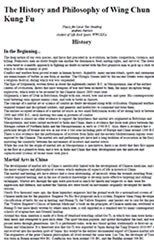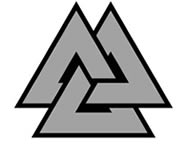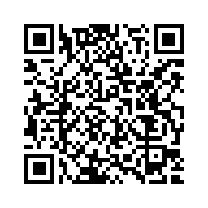
Author : Nerlich Andrew
Title : The History and Philosophy of Wing Chun Kung Fu
Year : 2004
Link download : Nerlich_Andrew_-_The_History_and_Philosophy_of_Wing_Chun_Kung_Fu.zip
In the Beginning... The deep nature of our own species, and those that preceded us in evolution, includes competition, violence, and killing. Prehistoric men no doubt fought one another for dominance, food, mating rights, and survival. The dawn of a structured or scientific approach to fighting no doubt occurred with the first primitive man to pick up a stick with which to strike an enemy or prey. Conflict and warfare form pivotal events in human history. Arguably, many ancient rituals, sports and ceremonies are reenactments of battles in one form or another. The Olympic Games held by the ancient Greeks were regarded as a religious festival, during which war was suspended. The Epic of Gilgamesh, written down in about the eighteenth century B.C. in Mesopotamia, one of the earliest centres of civilisation, shows that most weapons of war had been invented by then, the major exception being explosives, which were to be invented by the Chinese almost 2800 years later. Gilgamesh, a hero of Uruk in Babylonia, fought with axe, sword, bow and arrow, and spear. His contemporaries used battering rams against enemy cities, and rode to battle in chariots. The concept of a martial art or science of combat no doubt developed along with civilisation. Organised warfare required trained and disciplined soldiers, and generals and instructors to command and train them. The earliest accepted evidence of a martial art exists in two small Babylonian works of art dating back to between 2000 and 3000 B.C., each showing two men in postures of combat. Whilst there is almost no other evidence to support the hypothesis that martial arts originated in Babylonia and Mesopotamia, and were carried eastward to India and China, there is evidence that trade took place between the Harappa culture of Northern India and the Mesopotamians as early as 2500 B.C. Also, there is evidence that a particular design of bronze axe was in use over a vast area including parts of Europe and China around 1300 B.C. There is also evidence that the performances of acrobats from India and the eastern Mediterranean regions were enjoyed by the Chinese. The martial arts and performing arts have had a long tradition of association in the East, mirroring the similarity between the movements of acrobats and martial artists. While the case for the origin of martial arts in Mesopotamia is speculative, there is no doubt that they first appeared in the East in a primitive form, and it was in India and China that their development into the intricate and sophisticated systems of recent times took place. Martial Arts in China The development of martial arts in China is inextricably linked with the development of Chinese medicine, and of the major religious and philosophical systems which underpin all aspects of life in historical China. The martial and healing arts have always had a close relationship, of necessity when the wounds resulting from combat required healing, and in the use of medical knowledge to develop more effective targeting and striking techniques. Martial arts through the ages were practiced as much for health and longevity as they were for aggression and defence, and indeed the Shaolin arts were based on movements originally developed for health reasons. Nearly five thousand years ago, the three legendary emperors laid the ground work for a nationalised system of Chinese medicine for the populace. Emperor Fu Hsi first proposed such a system; Emperor Shun Nung developed a classification of herbs for use in healing; and Huang-Ti, the Yellow Emperor, sent healers out to care for the people. The "Yellow Emperor's Classic of Internal Medicine" a book on the principles of Chinese medicine, attributed to Huang-Ti but more likely written by others much later, is still regarded as a standard text by many contemporary schools of acupuncture and Oriental healing. Around this time, mention is made of a form of ritualised wrestling called Go-Ti, in which two men wore horns on their heads and attempted to gore each other. The sport became popular, and spread throughout the land, and was passed down through generations. Go-Ti is performed today, with less blood spilled, traditionally at festivals in Honan and Manchuria. It is theorised also that Go-Ti was exported to Japan during the Tang Dynasty (610-907 AD), and evolved into the modern sport of Sumo; this would be the earliest documented export of Chinese martial arts. The originators of the great Chinese philosophies all lived around the same time. Lao Tzu, the developer of Taoism, was born in Honan around 604 BC. Confucius was born around 550 BC, and the Buddha around 506 BC. ...

Demolins Edmond - L'éducation nouvelle
Auteur : Demolins Edmond Ouvrage : L'éducation nouvelle Année : 1898 Lien de téléchargement :...














